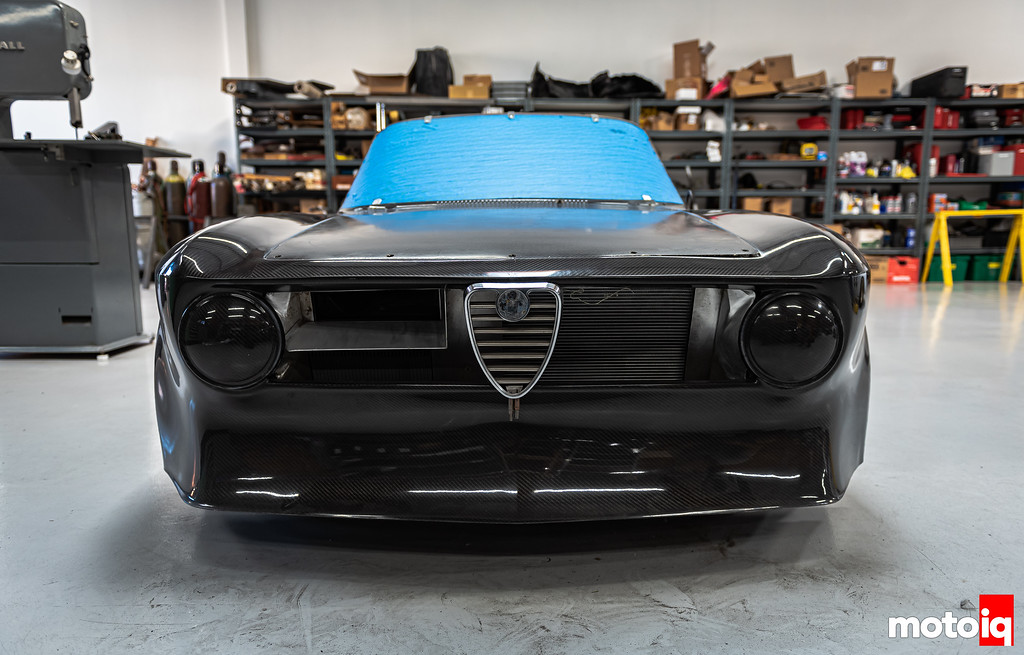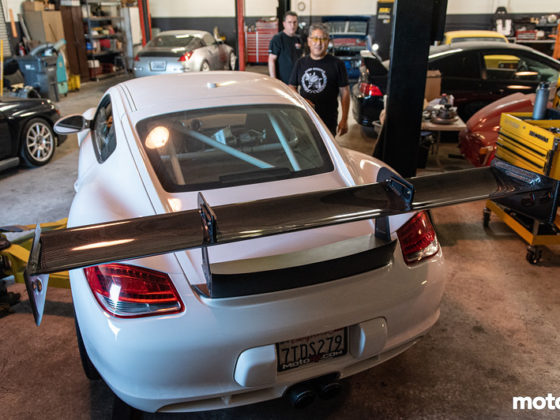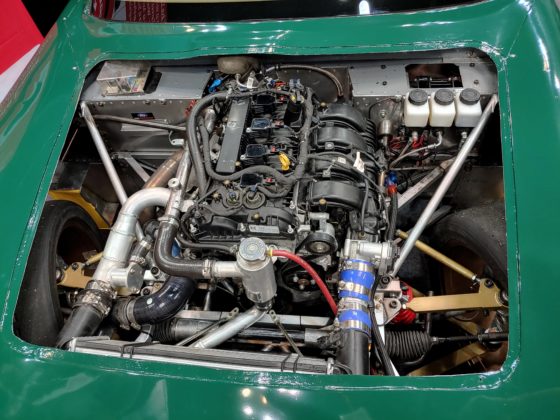
Ohlins TTX 4-way adjustable coil overs are used in the rear suspension. They are mounted on weight jackers stolen from a circle track car. I really like this feature because ride height and corner weights can be quickly adjusted independently from spring preload.
A Speedway Engineering tubular rear anti-sway bar is used with a blade type adjuster making adjustments fast and easy.

You can see how the weight jacker works here, just crack the lock nut and spin the threaded rod. No fighting the spring with a spanner that wants to slip off and bust your knuckles!

Here is the high mounted tubular Speedway Engineering anti-sway bar.

The rear TTX dampers are adjustable for high and low-speed compression and rebound damping. The adjusters are easily accessible for quick adjustments in the pits.

The front suspension is unequal length A-Arm with fabricated uprights and modern low scrub geometry. The suspension is designed for low bump steer, good camber curve, good roll center height, and is fully adjustable.




17 comments
What a treat!!! thanks!!!!
Going to have to dig into this since there’s a lot of cool details and I’m building a GT-3 car too. Trying something new with rear axle location (well, modified Mumford) that has rear roll center around 2″ off the ground and stationary relative to CG… well, it works in CAD, we’ll see in real life.
As alluded to, the Alfa’s gone a bit past GT-3 spec given the displacement. A lot of cool details here, like the weight jackers mentioned. I really like the chassis mounted Watts – the very definition of roll center not moving relative to CG with wheel movement. A lot of guys are using Lotus link rear suspension nowadays, but I really feel like 3 link plus whatever is better. The front suspension is a big series of tradeoffs; it looks like the choice picked here is a bunch of kingpin inclination. With 7 inch wheels and 9-10 inch tires, something has to give. Lovely looking uprights, good looking chassis triangulation, the whole car looks great.
Dan, don’t go that low for your rear roll center. It should also be higher than the front.
Mike, lowest adjustment puts the front at ground level and rear at 2 inches, stationary with respect to CG; they can both go up an inch or two pretty easily. I’ve heard some things from formula car people that it might be interesting to try running that low, but nice thing about tube cars is there’s plenty of scope to build in adjustment. I’m just psyched that I came up with a potentially useful new rear axle location setup.
I would go up for both an inch or two.
Depends on if you will rely heavily on aero or not. The formule guys (I was one of them) use that because they are relatively light and have realativy high downforce. Going that low is only usefull in those circumstances. So I’m with mike on this one.
Suspension in Formula cars is actually more of an afterthought and packaging deal nowadays. At least in F1.
Interesting TB’s built into a DCOE like carb housing. The FI can be tuned on a lap top, and be better controlled. It looks like it was made to be a direct replacement for Webers ( & their fakes), so existing manifolds could be used. Clever Idea!
I put trip weber DCOE’s on a GT6 that I had built, but they were for a larger TR6 engine. I paid almost as much in new parts (6 of each) as I did for the original kit! Initially not much more power, but it made a huge improvement once I modified the engine per Kas Kastner’s Booklet.
Love this build, thanks for sharing. Never knew about those Webber carb-esque ITBs, I’ll have to check those out for my 2002.
@ Mike Kojima:
Tell the owner that by placing copper spacing rings underneath the cylinders and by milling the upper part of sleeve into the cilinder and using a copper headgasket, the cylinders won’t start to walk during very high horsepower applications. Let him look at VW and Porsche aircooled engines. The cars where actually made with a turbo from the factory later in life in the Alfa 75. Really cool build!
One thing I’m wondering though: Why not use the transaxle used in a lot of alfa’s with inboard disc brakes? The alfa 75 being just an example?
GT-3 rules say the trans front seal has to be within 12″ of the engine rear main seal. Car might be a little past GT-3 rules in the engine department as presented in the article, but the rest of it seems like it’s still GT-3.
A right, that explains a lot! But does that also apply to cars that standard come equiped with a transaxle? As I said, the Alfa 75 came with the same engine and the transaxle with inboard disc brakes on all variants.
SCCA classes have kind of “baseline assumptions” of what the intent is for something in that class – except for some classes that turned into “catch all” classes where they lump stuff in that makes broadly similar lap time in a broadly similar way. So one class “down” in Production, the “baseline assumption” is that you’ve got a heavily modified unibody car with maybe widebody and stuff, and slicks of a given size and such and such power to weight, and the stock gearbox or something with a gear kit in it if you accept the minimum weight penalty. There, the “rear transaxle is how it came stock” is totally game because hey, you’re probably running the stock driveline or something close, and a few enthusiast cars did that. GT the assumption is that it’s a silhouette car with basically nothing stock anyway and they don’t want to give drivetrain allowances for specific cars.
Now, all of this aside, an important context is that most of the SCCA GT class cars are _actually_ ex-various-pro-class cars; most of the current GT-3 field was Nasport (I think Mike might know more about that) and before that was often more heavily modified IMSA RS cars, GT-2 (before it turned into a catch-all) was basically IMSA GTU or GTS-3 cars, and GT-1 is basically Trans Am stuff. So some of the build configuration stuff is holdovers from that and nobody really wants to get into a major development arms race. Usually if you show up with an existing car that was built to a different rules set but is similar they’ll write a place for you in the rule book (the Grand Am tube chassis RX-8 with a rear transaxle got a spec line in GT-2 for example) but a new build car I don’t think anyone would be sympathetic to going past the established stuff.
Totally different compaired to FIA regulated events where I’m familliar with. Over here it’s: Not in the rulebook? Not allowed. But in essence tje GT3 class over there is kind of spec class, where over here it is a production based racing class that are homologated for racing in the class.
Yeah, no relation between the two GT3 classes; it all falls down to SCCA is a club that people join to go racing and theoretically is directly answerable to the people racing, whereas the FIA isn’t. It’s a sanctioning body but not pro racing.
Worth mentioning though that FIA GT3 cars are eligible to run in SCCA GT-1, albeit mostly because people who own the cars asked. Don’t know that they’d be competitive at the big tracks though, but they’re legal. Almost any ex-Pro or Pro-who’s-running-for-fun stuff GT3 or slower is eligible somewhere in SCCA if they ask.
Does anybody know who actually engineered and built this? Dino?
A bunch of people, a lot of credit goes to Steve Ruiz and his son.
Steve, Dino and Mike?
DREAM TEAM!